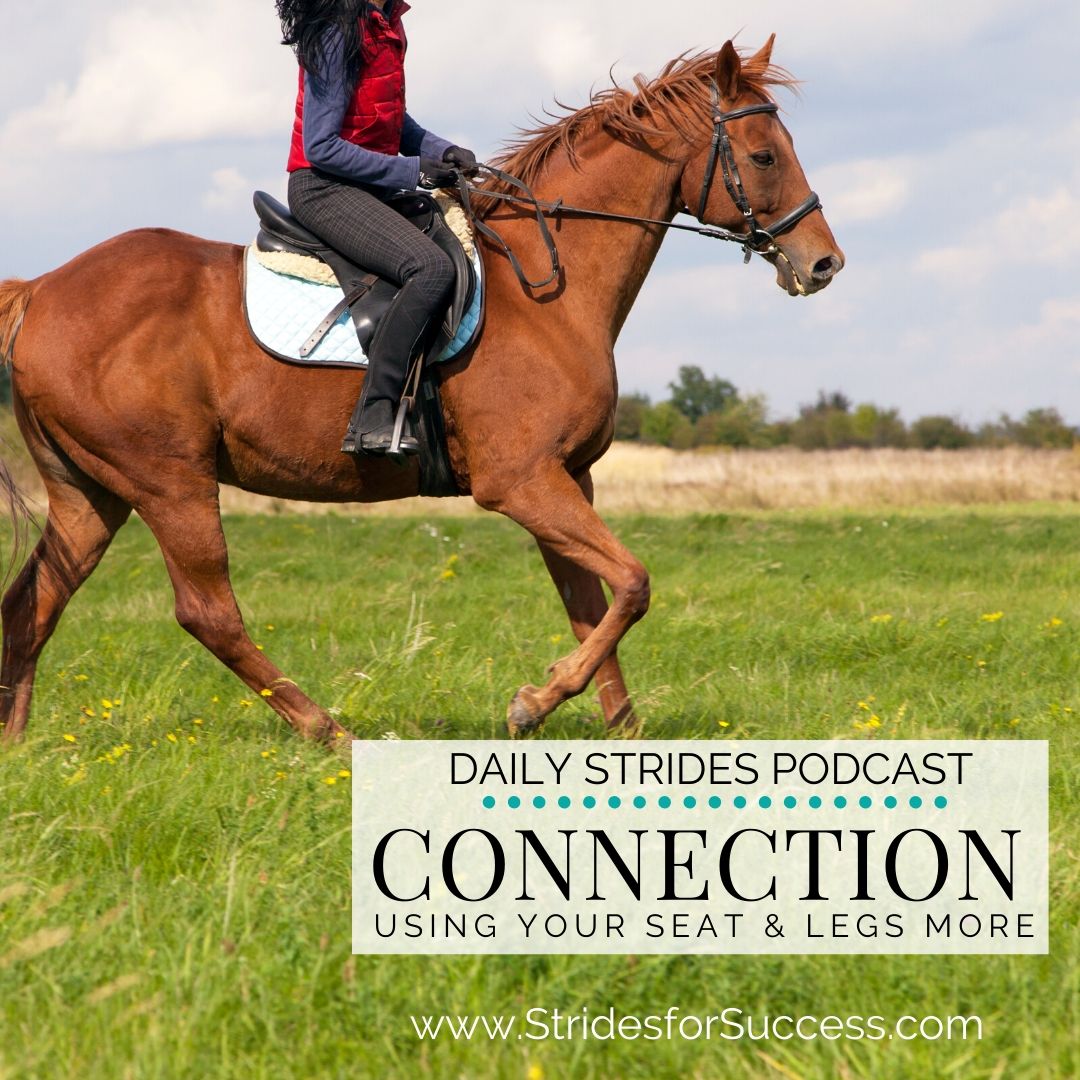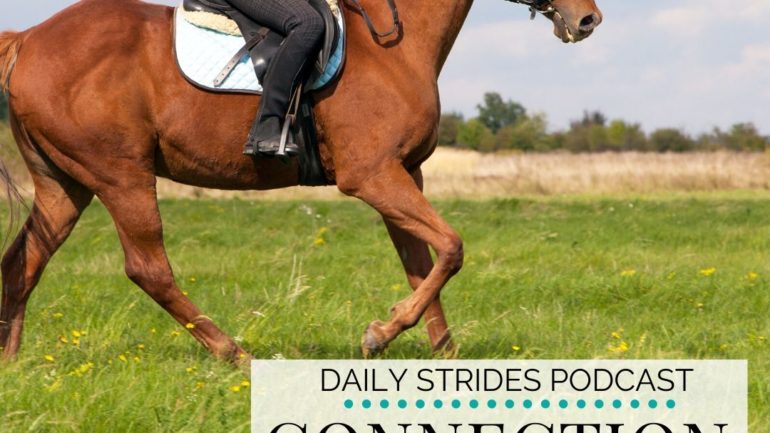
Have you ever thought about what you can feel, in the saddle as you ride your horse? The physical connection points you have with your horse each time you’re in the saddle.
Often we can become so caught up with our aids and what we ‘should’ be doing, that we forget to focus on the actual points of physical connection between you and your horse. And the impact these connection points are having on each ride.
Mount Up & Begin Walking
The first thing I am going to suggest is to actually mount up and simply allow your horse to walk. It is amazing how often we forget to allow this to happen. We think that because we are in the saddle and the horse is moving underneath us, we are allowing the walk.
And yet, so often we are blocking or working against our horse doing this simplest of tasks. Walking freely while we are in the saddle.
How many times have you been in the saddle and focus on ‘getting the horse to walk’? This versus sitting back and actually just allowing the horse to walk.
Doing Nothing
One of the biggest challenges riders have is to do nothing. Not that I am telling you to do absolutely Jack Squack in the saddle! Rather any ‘doing’ your ‘doing’ is focused on yourself, rather than your horse. Things like carrying yourself. Another often overlooked part of riding for many riders.
The simple act of mindfully beginning to carry your upper body, allows your lower body to follow, rather than remain ‘stuck’ between your ribcage and the saddle.
The ‘doing nothing’ I am referring to is regarding swinging, forcing, shoving or any other ‘ings’ you can do that involve you ‘trying’ to get your horse to walk. Simply make sure that you are in the best possible position to allow your horse to walk; and in doing so, move the part of your body that is connected to the saddle.
You are allowing your horse to move your seat; not you shoving your seat in order to move your horse
Remain Independent
Remaining secure and balanced of your own accord are the basics of independence. A quick test of this, as a rider, is to imagine you could instantly make your horse vanish. How would you land on the ground? On your feet? If so, you’ve got this covered already, congratulations! On your face or bum means that you have an issue with your other connections points; your legs.
There should not be daylight between your legs and your horse’s sides. This is especially true of your thighs and your lower legs or calves.
Your independent seat depends on your abilities to balance yourself. This depends on how you have positioned your body in the saddle. Any tipping, gripping, toppling, or leaning means that you are using your horse for balance.
Using your connection points to hold on means that they cannot be part of the actual conversation. They are no longer aids and are pretty useless when communicating.
Connection Points Between You And Your Horse
Once you have positioned yourself so that you are carrying yourself, notice your legs. There should not be daylight between them and your horse’s sides. If there is, it usually means you are gripping or pinching somewhere higher up. Allow your legs to drape. To hang from your hips.
Your legs are an important part of the conversation between you and your horse. However, because many riders do not use them correctly, they are misunderstood and ignored by the horse.
Your legs are not to keep you on the horse. Rather to communicates with your horse. No one likes a ‘Cling-on Warrior’; meaning if you are using your legs to hold you on, you are taking advantage of your position. Rather allow your legs to ‘drape’. Let the weight drop down into your heel. And from there, your legs can actually be used for what they do best; to communicate with your horse.
Your Seat & How it Feels
Like I’ve said already, your seat is a valuable communication aid in the conversation with your horse. But only if you first learn to ‘allow’ through it. Allow your horse to move your seat, rather than you moving your seat in order to move your horse.
I want you to zone in on how this feels. Actually, it physically feels. One of the first things you may notice is that there is a rhythm to it. Forwards and backwards rhythm to the physical movement. Stay with this feeling a while.
Notice how there is also an ‘up and down’ to the movement. It too is in rhythm.
When I am explaining this to riders, I often think of the pedals of a bicycle. Except when its the horse it is the other way around. Forward and down, backward and up. Rotation of your seat bones. Moving with the horse and allowing the horses back to move them.
The Rhythm of the Conversation
Have you ever been part of a great conversation with someone, and someone else will randomly just ‘butt in’ to your conversation? They may or may not be even speaking about the same topic. It doesn’t matter. The simple act of their interruption is enough to work against the natural flow or rhythm of the conversation.
I think that if you are honest with yourself and begin thinking about your conversation with your horse like this, you’ll notice places where you’re not being as consistent as you would like. Your leg aids. Randomly going between squeezing to stay on and squeezing because it’s now an aid. Your seat; moving between digging, shoving, and the occasional half halt.
Riders have a habit of ‘butting in’ randomly in the ongoing conversation between them and their horses. The the two most common places this happens is with the aids that form the natural physical connection between them.
Get Clear on Your Connection & Your Aids
You can always refine your aids. There are the basics, such as your position, your posture, and using the actual aids themselves, you get to play with the next level of this connection. The timing element. However, you can only begin to do all of this when you wake up to what you are currently ‘saying’ in the saddle, right now.
Timing is the place that you can really take the conversation to a new level between you and your horse. Using your existing connection and timing how you communicate with it.
However, it all starts with taking a good hard, honest look at what is currently happening with your seat and legs while you ride. Then mindfully beginning to change how you are using your connection to help enhance the overall conversation.
Happy Riding
Lorna
Additional Resources to Help
-
-
- Your Independent Seat is a Result of Your Independent Aids
- Your Independent Seat is Everything in Your Riding
- Improving Your Feel in the Saddle
- Learning to Stop Driving with Your Seat
- The Original Returning to Riding Plan
- The Full Returning to Riding Program
- Free Equestrian Fitness Challenge
- Daily Strides Podcast
-

